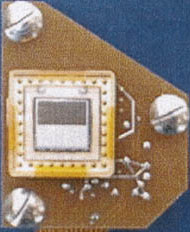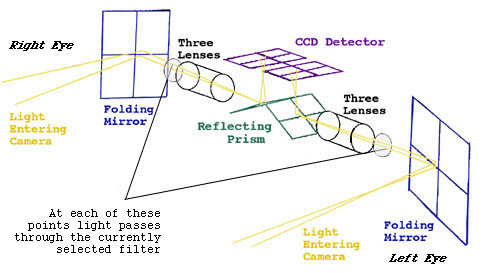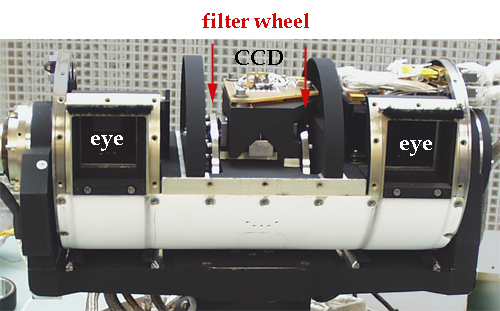
this page is still under construction. If you
have any questions or comments, click on the "send us your
questions" link at the bottom of the page.
|
The Imager for Mars Pathfinder
(IMP) and the Surface Stereo Imager (SSI) are nearly identical.
The IMP flew on the Mars Pathfinder mission, and took more than
16,000 images of the Martian surface in Ares Vallis between July
4 and September 27, 1997. The SSI will be launched in January
1999 as part of the Mars Volatiles and Climate Surveyor package,
on the Mars Polar Lander '98 mission. In late 1999 it will
land near the south pole of Mars. In this page, for convenience,
IMP images are discussed. However, the same facts apply
to SSI images.
|
 How the IMP Records
Images
| Anatomy:
Dissecting an IMP Image | How the IMP Filters Work |
more information is available
in How the IMP Works
How the IMP Records
Images
| Anatomy:
Dissecting an IMP Image | How the IMP Filters Work |
more information is available
in How the IMP Works |
Words in italics are defined
in our glossary, click on them to see their definition.
If a word is used repeatedly, only the first few usages are linked
to the glossary.
Anatomy: How the IMP
Records Images
Perhaps the best way to begin thinking about the way that the
IMP records images is to begin by considering the nature of cameras.
We all look at pictures, but do we always think about what they
really are? Cameras are devices which record the light that
is reflected off the objects in the scene with which they are
presented.
Unlike a conventional camera, the IMP does not record images
on film. Instead, light reflected off objects is focused
within the camera head and projected onto a "CCD," a
Charge Coupled Device. To understand how our CCD works,
and why we chose to use a CCD camera for the Pathfinder mission,
let's begin by thinking about traditional cameras, which record
images on film.
When you take an image with a traditional camera, using ordinary
photographic film, you expose film to the light being reflected
off of objects in the scene. That light strikes the
chemicals on the film, and causes them to react. With black
and white film, there is one layer of chemicals which is affected
by all of the visible reflected light.
With color film, there are multiple layers of chemicals coating
the film. Each layer is affected by a different wavelength
of light. One layer of chemicals is affected by green,
one by red and one by blue. Thus, when we have a color print
made from a negative, the colors that we see are composed of red,
green and blue, but these colors are inseparable.

|
In the IMP, the CCD takes the place of film. The CCD
is a small chip, which, unlike film, is broken up into very small
finite blocks (we'll call them cells). Light travels through
our camera's eyes, is reflected by mirrors, passes through filters
and lenses, and then is reflected by a prism onto the surface
of the CCD detector. Just like film, the CCD is affected
by the photons of light which hit it. Each time a photon
hits the surface of the CCD, an electron in one of the cells
is knocked out of place. Bright areas of the scene reflect
many photons of light, dark areas reflect fewer photons.
Each area of the scene is focused onto a specific area of the
CCD, thus, some areas are hit with many photons, and some with
fewer photons.
Larger image of the CCD, with electronics |
* If it is hard for you to imagine this, picture
a slide show. Parts of the screen are light and parts are dark,
depending on how much light is shining through the slide.
Imagine someone has drawn a large grid, like graph paper, covering
the entire screen. Now pretend that you have a way of counting
each photon, that is, each small clump or drop of energy/light
that fell in each square of the grid. That is essentially
how the CCD detector works. Light reflected from all the
objects in front of the camera is being focused on the CCD chip,
and each bit of reflected light must fall somewhere on that grid.
By effectively counting how many bits of light fell in one area,
we can determine how bright or dark that area is.
Comparing the steps to an image:
Conventional mechanical 35 mm camera:
|
The camera opens the shutter, focusing
light from objects in the scene |
The light reacts with the chemical coating.
Bright areas of the scene reflect more light, forming a pattern
on the film. |
After being chemically developed, an analog image of the scene
is left on the film. |
The processed film can be used to make slides or prints of the
image. |
The IMP:
|
The CCD is exposed to light, after it is
focused and has passed through a chosen filter. |
The photons of reflected light hit the
CCD detector. Each individual cell of the CCD builds up a charge
proportional to the number of photon which have struck that cell. |
The charge on each cell is read out, cell by cell by a piece
of electronics. |
Another piece of electronics is used to assign each cell a number,
according to the amount of light which struck that cell. |
The numbers are sent through space via
radio waves. Once on Earth we can recreate the Martian
scene by assembling the bright and dark pixels in order. |
As you can see, the first stages of taking an image consist of
either chemical or electronic reactions in the film or CCD.
The last stages of taking an image with the IMP are quite different,
and it is those differences which make the CCD more practical
for planetary exploration.
One reason is that the CCD images begin their existence in
segments, the cells, which makes it easy to convert them to
pixels. Each cell becomes a pixel after it
has been assigned a numerical number. Images recorded on
photographic film are analog -- they are continuously variable
instead of being broken into small bits. This fact makes
it harder to represent the images as numbers.
Why would you want to break an image down into numbers?
Scientists need a method of analyzing the image data which can
be quantified. With an analog image, like a photograph,
you can say "rock #1 looks darker than rock #2," and
that does teach you something. However, with our digital
images, we can assign numbers to the differences between the two.
This is only one example of many -- we can also take images of
the sun and determine the qualities of the atmosphere by seeing
quantitatively how much light is passing through it.
The image below shows the path of light (indicated by yellow
lines) as it travels through the camera and is projected onto
the CCD.

|
(for simplicity, many parts of the camera have been left out,
including the filter wheel. This image simply shows the light
path to the CCD Detector within the camera head.) |

|
This image of the SSI without its top cover shows the eyes ,
the filter wheel, and the top of the CCD. Click on the
image for a larger version. |
| Anatomy: Dissecting an IMP Image | How
the IMP Works | Send
us your questions about the IMP |
Return to IMP
Homage



